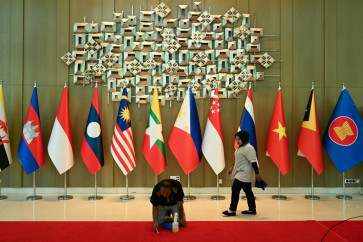Addressing Indonesia’s green investment gap
Indonesia has begun to tap into the green bond market, both at home and overseas, to finance environmentally friendly projects
Change text size
Gift Premium Articles
to Anyone

I
ndonesia has begun to tap into the green bond market, both at home and overseas, to finance environmentally friendly projects.
In February, Indonesia issued sovereign green bonds worth US$1.15 billion in the international bond market, the first sovereign bonds issued by an Asian country. Just recently, state-owned infrastructure financing company PT Sarana Multi Infrastruktur (SMI) announced it would offer green bonds of about Rp 1 trillion in the local bond market by the end of the first half to boost its financing capacity. If realized, SMI will become the first company to issue domestic green bonds.
Green bond issuance could become an important financing alternative to finance future infrastructure projects.
Driving strong economic growth without harming the environment is not impossible. The Organisation for Economic Cooperation and Development (OECD) has stated that, with the right mix of “green policies”, G20 countries’ GDP can grow by up to 5 percent on average in the medium term, counting in the net effect of stronger climate change mitigation.
Indonesia has made a major breakthrough in adapting green policies following its fossil fuel subsidy reform in 2014.
At the national level, Indonesia has issued Government Regulation No. 61/2011 on the National Action Plan for Greenhouse Gases to support green projects. However, the country has yet to create a national financing strategy as an integral part of its green growth policy. As seconded by the OECD, accelerating investment is of utmost importance in implementing the Indonesian agenda for green growth.
Currently, public finance still dominates ASEAN’s green finance market by around 75 percent. With the fiscal deficit remaining high in most ASEAN countries, including Indonesia, financing sources for green projects should come from private funds. However, according to a Bank Indonesia survey, green commercial banks are still reluctant to provide loans for green projects. Less than 10 percent of the banks’ loans are disbursed for green projects, while their disbursement remains hampered by the absence of risk assessment capacity, standards and supervision for green projects.
However, even if banks increased their loan disbursement, the financing gap remains. According to a joint report by DBS and the United Nations in 2017, ASEAN will need $3 trillion in green investment, or about 37 times the 2016 global green market. In order for banks to cover the gap, they need to grow by 12 times — a very challenging demand, especially for Indonesia that will soon be implementing the Basel III international regulatory framework. According to Gursoy (2016), the tighter regulation will potentially discourage green loan growth among banks.
Therefore, other financing possibilities, such as capital market financing, should be explored. In 2016, capital market financing only accounted for less than 5 percent of total private investment. The higher risks embedded in green projects compared to conventional ones lowers its access to capital market financing. Although the degree of risks could differ across subsectors, the average risks still remain higher.
Aside from risks, insufficient environmental disclosure, limited information-sharing platforms, unclear definition of green projects and the limited number of pipeline projects are also considered key challenges to capital market financing.
Recently, the Financial Services Authority (OJK) launched Regulation No. 60/POJK.4/2017 on Issuance and Requirements of Green Bonds as part of the implementation of the OJK Roadmap for Sustainable Finance. This could become an important guidance in green bonds offering that could encourage more companies to issue green bonds.
More recently, there is an ever-higher urgency to promote more innovative capital market financing.
Public finance still dominates ASEAN’s green finance market.
In May, the government will promote securitization as an example of financing that will not worsen the leverage position of state-owned enterprises (SOEs). This is very important, considering the SOEs’ current leverage position and the fact that securitization had already started in 2017, when two SOEs issued highly oversubscribed Asset-Backed Securities (ABS) for infrastructure.
Furthermore, securitization is a naturally suitable investment product for green financing that is attached to a specific standard. The 2016 case in Australia was an indication that investors are interested in such innovation.
In 2016, the Australian and New Zealand consumer and SME leasing company, FlexiGroup, issued Australia’s first labeled green ABS. This transaction contributed to major improvement in the region’s green finance market by introducing a structure that can tap bigger funds ($260 million) by using ABS ($50 million of “Climate Bond Initiative-certified green tranche”).
A “recycling system” was also added to the structure that links green proceeds to further green asset expansion — in this case the solar photovoltaic (PV) system, which made it more appealing to investors.
The potential of ABS is also real. By the end of 2017, the ABS green market facility had grown to $1.3 billion. While the contribution of securitization to the green finance market is considered minimal, only 1 percent as of Jan. 31 2018, growth looked very promising from only $100 million in 2013.
On the other hand, demand is still low despite high investor appetite. Since the Paris Agreement, there has been very high demand from foreign investors, seen from Indonesia’s highly oversubscribed first sovereign green sukuk (Islamic bond).
In order to increase investors’ participation, an integrated demand-side strategy is needed. One strategy is to provide incentives for investors, which currently does not exist for green investment.
While it is known that Indonesia has adopted a model that offers different incentives based on a sector’s maturity, for example Government Regulation No. 100/2013 on Capital Gain Tax, incentives for the new green market sector are yet to come.
Tax incentives consist one important, although not the sole, factor to attract investment. This way, more kinds of investors, including non-banks, are expected to increase their contributions to the green market.
Furthermore, the private sector, regulators and practitioners should work together to create a comprehensive financing strategy for accommodating more green finance innovation in the future.
The OJK, for instance, could help by providing more guidance on not only green bonds, but also on green finance instruments as a whole. These instruments are relevant, especially for penetrating other markets in the future, including digital and micro finance markets.
_________________________________________________
The writer is an economist at the Finance Ministry’s Fiscal Policy Agency. This is her personal view.









